Sevilla’s 2022/23 campaign was an absolute rollercoaster. Things started out shakily under Julen Lopetegui, who was ultimately sacked just 10 games into the season having managed to guide his club to just one victory in that time — a 3-2 away win over Espanyol.
That early-season period under Lopetegui saw Sevilla suffer some crushing defeats, including a 3-0 loss at home to Barcelona in LaLiga, a 4-0 loss at home to Manchester City in the UEFA Champions League and a 4-1 UCL loss at home to Borussia Dortmund which proved to be the final nail in Lopetegui’s coffin.
The Spaniard would be replaced by Marcelo Bielsa disciple Jorge Sampaoli who returned to Andalusia for his second stint in charge of Los Nervionenses coming off the back of a positive period with Ligue 1 giants Marseille.
The majority of the campaign was contested under the 63-year-old Argentinian’s watchful eye but despite his illustrious background, Sampaoli’s tenure ended in failure, as the coach was sacked in late March following a 2-0 defeat to Getafe which left Palanganas just a couple of points above the relegation zone — not at all a position becoming of a team with aspirations of European success.
Sampaoli was replaced by a coach with a completely different approach to the game: José Luis Mendilibar. The new coach implemented some changes and this saw Sevilla turn their fortunes around, firstly getting some much-needed points on the board in LaLiga to get clear of the drop zone (they eventually finished 12th — nine points from relegation), while they also managed to knock Manchester United and Juventus out of the UEFA Europa League on their way to the final versus Roma, which they eventually won via the penalty shootout.
A mixture of emotions that led the Sevilla faithful from dejection to elation, no doubt, the 2022/23 season is one that they’ll largely be glad to see the back of and hope to build on their strong finish and carry some momentum into, hopefully, a better league campaign in 2023/24.
This tactical analysis and team-focused scout report will be split into three parts, firstly looking at what change Mendilibar has overseen since taking charge of Los Nervionenses for his first game on 1st April, secondly looking at where he can still take the team forward tactically, and lastly looking at some areas Sevilla could try to bolster their squad in the summer in order to help Mendilibar out with his mission for 2023/24.
How have Sevilla changed under Mendilibar?
I was tempted to start this article by looking at where things were primarily going wrong for Sevilla under Sampaoli, however, it’s pretty well-documented already and if you’re in need of a refresher on that, we have a tactical anasis article here at Total Football Analysis that can fulfil your needs: ‘Tactical problems which led to Jorge Sampaoli’s sacking at Sevilla – scout report’ or a video on our YouTube channel if you prefer to consume your analysis content in that manner.
In any event, to summarise, for a multitude of reasons, the highly possession-based, controlled style of Sampaoli failed to inspire the necessary results. They failed to create enough chances, their possession play was too predictable and this predictability allowed silly avoidable unforced errors to creep into their game and imbalances in their positional structure in possession made them very vulnerable to counterattacks that their team failed to provide enough energy to effectively defend against.
Since Mendilibar has joined, strategy and tactics have become a little ‘simpler’ in some senses. Sampaoli is generally a very philosophy-driven coach who has a very specific system he likes to try and implement on his team.
Mendilibar is also quite system-driven but in a different manner which professes a style of play that’s less unique to him. In short, he loves high pressing and rather direct play. He immediately switched Sevilla from playing with a quite positionally fluid, possession-heavy three-centre-back shape to playing with a more traditional 4-2-3-1 structure.
Additionally, Mendilibar got his team playing exactly the way he wants them to play very quickly, highlighting a benefit of the more universally familiar and in some ways less controlled approach he takes.
Under Mendilibar, Sevilla’s average possession percentage dropped from 54.9% to 46.7% while their average passes per 90 starkly dropped from 502.0 per 90 to 383.5 per 90 — connected with this, Sevilla’s average pass length increased from 19.5m to 20.1m. At the same time, their average shot distance decreased (19.2m to 18.3m) as their xG increased (1.3 per 90 to 1.5 per 90) and their average shots per 90 increased (11.7 per 90 to 12.9 per 90).
So, in other words, Sevilla created more shots in total while increasing their shot quality and giving themselves a higher likelihood of scoring in a given game at the same time as they rapidly became much more direct in their play, moving the ball forward over a distance much more quickly with fewer passes.
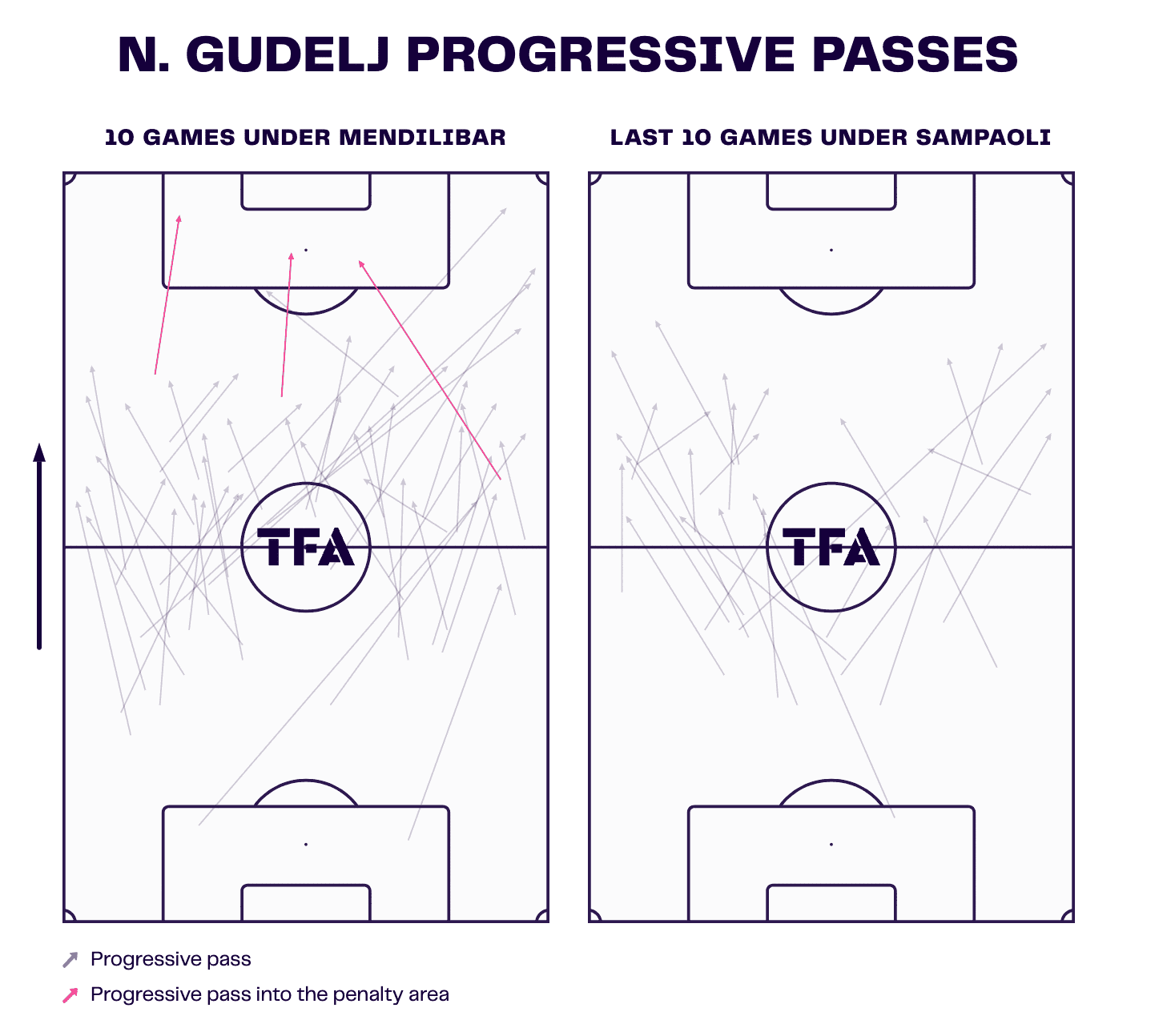
A couple of images here show some examples of the differences in Sevilla’s possession play pre and post-Mendilibar’s arrival. Firstly, figure 1 shows Nemanja Gudelj’s progressive pass map from the first 10 games under Mendilibar compared with the last 10 games under Sampaoli.
The holding midfielder’s passes give us a clear indication of the shift in style from one coach to the other, especially in regards to the direct nature of their play under Mendilibar compared to the more methodical, patient possession play they employed under Sampaoli.
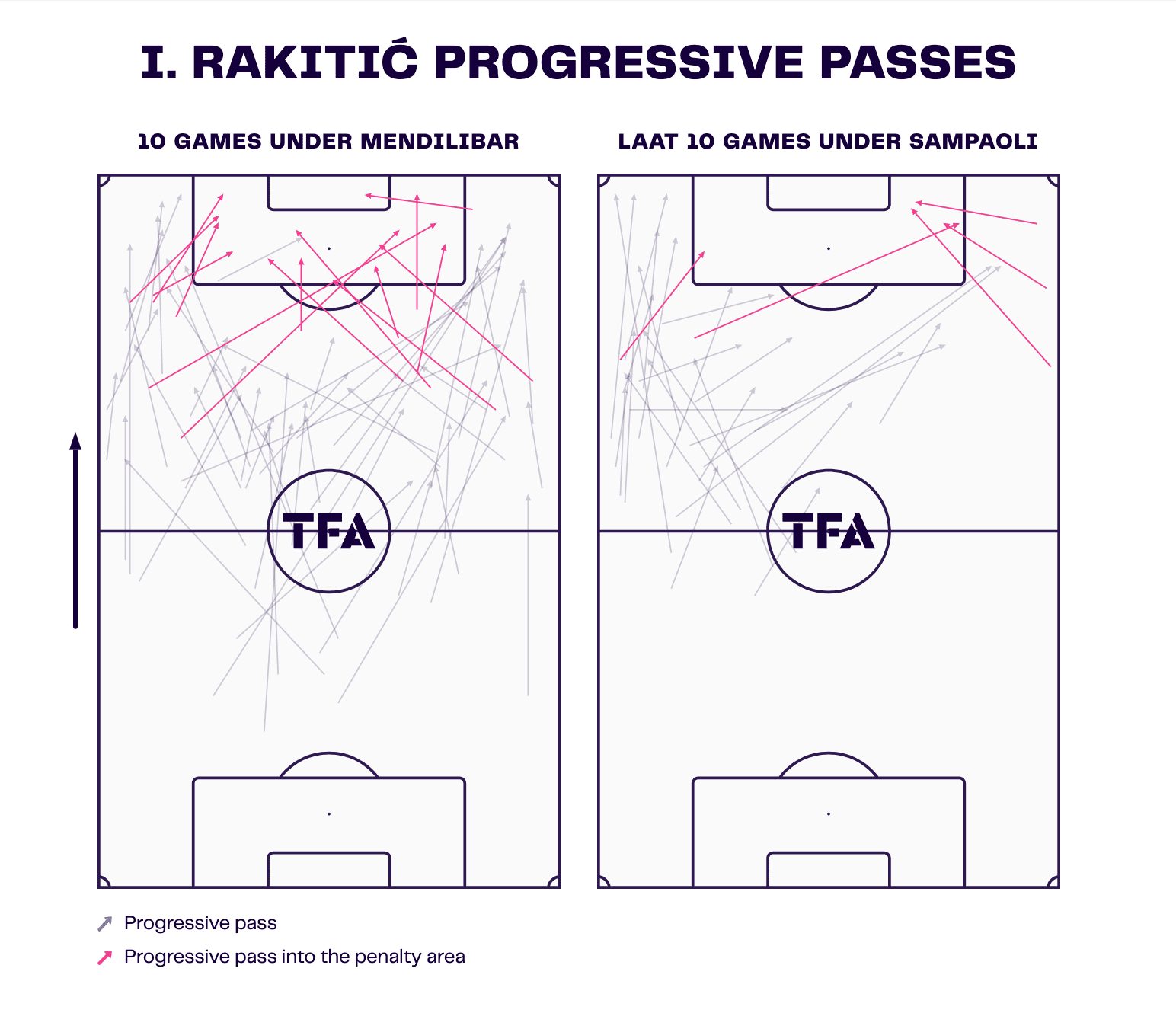
Similarly, midfielder Ivan Rakitić’s progressive pass map is completely different pre and post-Mendilibar, as figure 2 shows.
Under Sampaoli, Rakitić often ended up out in wide areas in the progression and/or chance creation phase, something we discussed in the aforementioned article looking at Sevilla’s problems under Sampaoli.
The Croatian midfielder was tasked with shifting out wide while wingers roamed and often came inside in the final third. However, these areas were not getting the best out of Rakitić and his skillset; they were unfamiliar and ultimately led to the 35-year-old not being as helpful as he could’ve been in possession.
Compare this with his progressive pass map under Mendilibar, when the 62-year-old simplified things at Los Nervionenses once more and focused a bit more on finding the best role for each individual as opposed to finding out how individuals could potentially fit into the system, we can see that Rakitić became far more productive in possession.
Shifting a 35-year-old Rakitić out wide epitomises this recent Sampaoli stint with Sevilla. The Argentinian was too focused on forcing square pegs into round holes in the hopes that the system would make the difference when it just served to put important players in positions they weren’t as comfortable with or as familiar with. With Mendilibar, things have run much more smoothly just by simplifying the system and putting more emphasis on putting the players in their best roles while shifting to a less possession-based system, overall.
Out of possession, there’s also been a major difference for Sevilla under Mendilibar than beforehand; their PPDA has dropped from 11.5 to 10.0. Again, if there are two things we know for sure about Mendilibar, they are that he loves direct play in possession and aggressive pressing out of possession. We saw both of these things quickly become features of Sevilla under the 62-year-old.
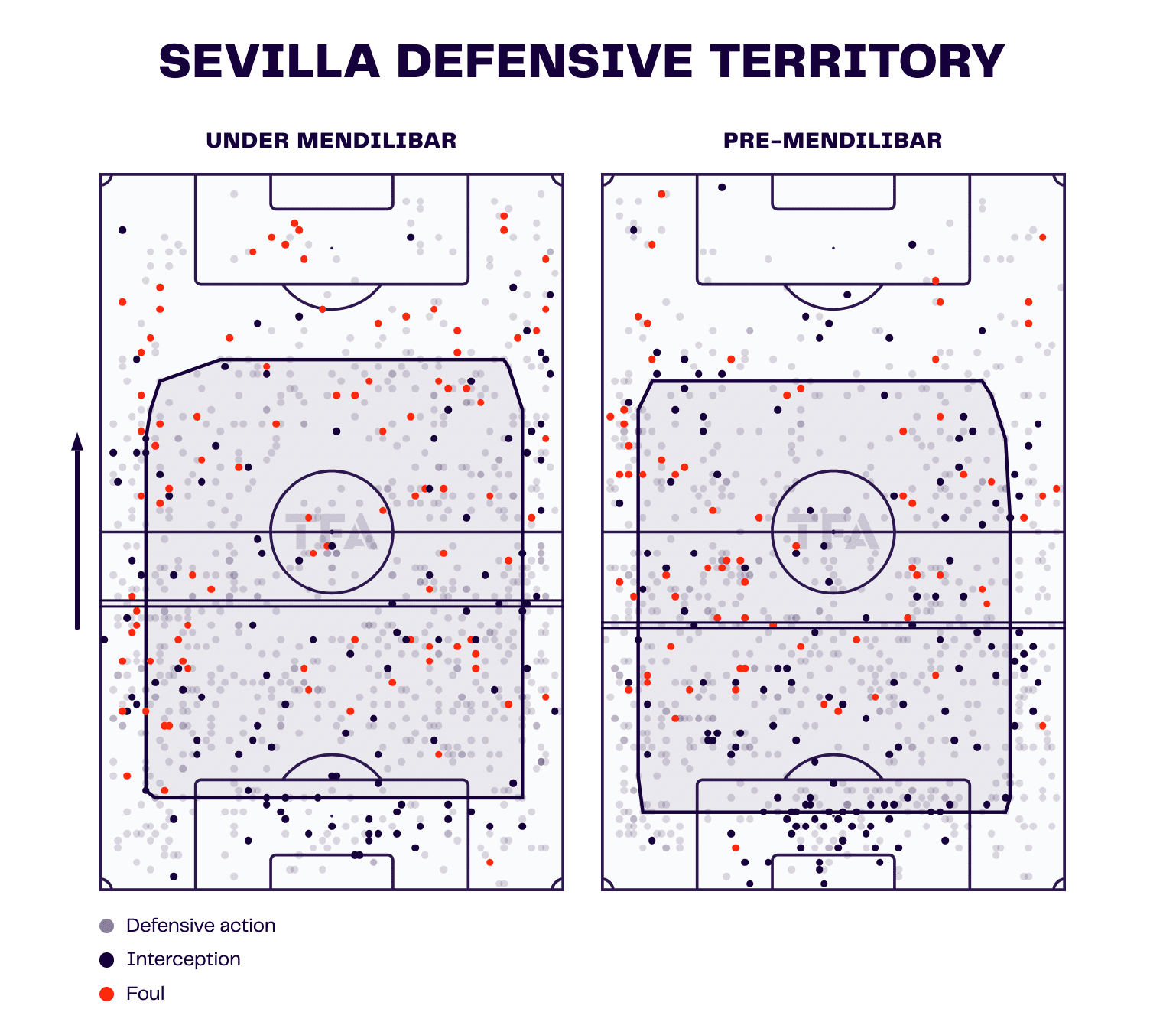
Figure 3 displays Sevilla’s defensive territory map from Mendilibar’s 10 2022/23 games and their defensive territory map from before Mendilibar’s arrival.
We can clearly see that Los Nervionenses’ average defensive line height has increased, getting closer to the halfway line, while their average defensive territory map has also crept up towards the opposition’s box.
Their more aggressive press under Mendilibar has paid off with Sevilla’s xGA dropping to 1.29 under their current manager. Their xGA sits at 1.39 for the 2022/23 campaign in its entirety, so we can see how Mendilibar is doing well to bring that number down.
For the season as a whole, Sevilla’s xG difference is –0.05 but during the Mendilibar era, it’s 0.16. So, their xG difference has improved by 0.21 — a not-insignificant amount — during their time playing under their current boss.
The Europa League champions will hope to continue in such fashion heading into the new season and their aggressive defending will play an important role in that.
Where can Sevilla still improve under Mendilibar?
Some areas of improvement for Sevilla under Sampaoli remain areas of improvement under Mendilibar — this is only natural considering it’s the same squad as before and the Europa League-winning coach only oversaw 10 games.
Los Nervionenses can still improve defensively but as mentioned in the previous section, they’ve already made excellent strides in this department just 10 games into Mendilibar’s tenure, so something like this that’s clearly moving in the right direction isn’t a key area of concern, for me.
One area in which Sevilla can definitely still improve, though, is in terms of shot quality and taking their chances better. While they’ve created more under Mendilibar, they haven’t drastically improved their goalscoring numbers and part of this comes down to the quality of finishing up front. Their average shot accuracy has actually dropped from pre-Mendilibar (36.7%) to post-Mendilibar (33.9%).
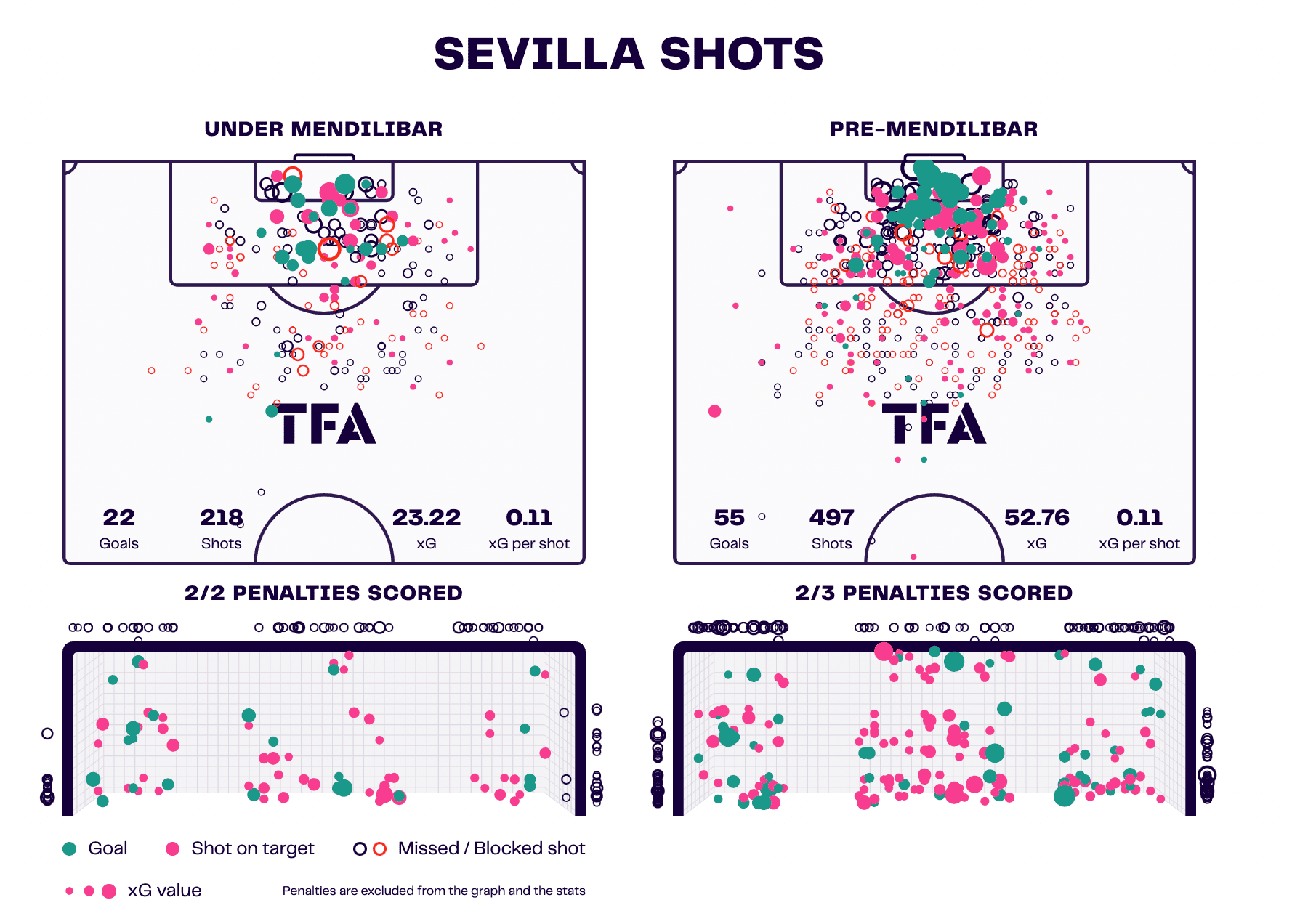
It’s excellent to be increasing your xG and shot numbers but you still need a clinical finisher up top to ensure these chances aren’t just created in vain.
Figure 4 shows Sevilla’s pre-Mendilibar and post-Mendilibar shot maps for 2022/23, and we can see how their xG per shot has remained the same while they’ve actually slightly underperformed their xG of late compared to beforehand where they slightly overperformed.
The difference in the latter is too marginal to make a concrete claim based on the underperformance/overperformance but it’s clear from the xG per shot as well that there hasn’t been much progress in this department and Sevilla will need to improve up front in terms of their positioning in the box and shot selection if they’re to make the most of the shots they take and be more efficient in front of goal.
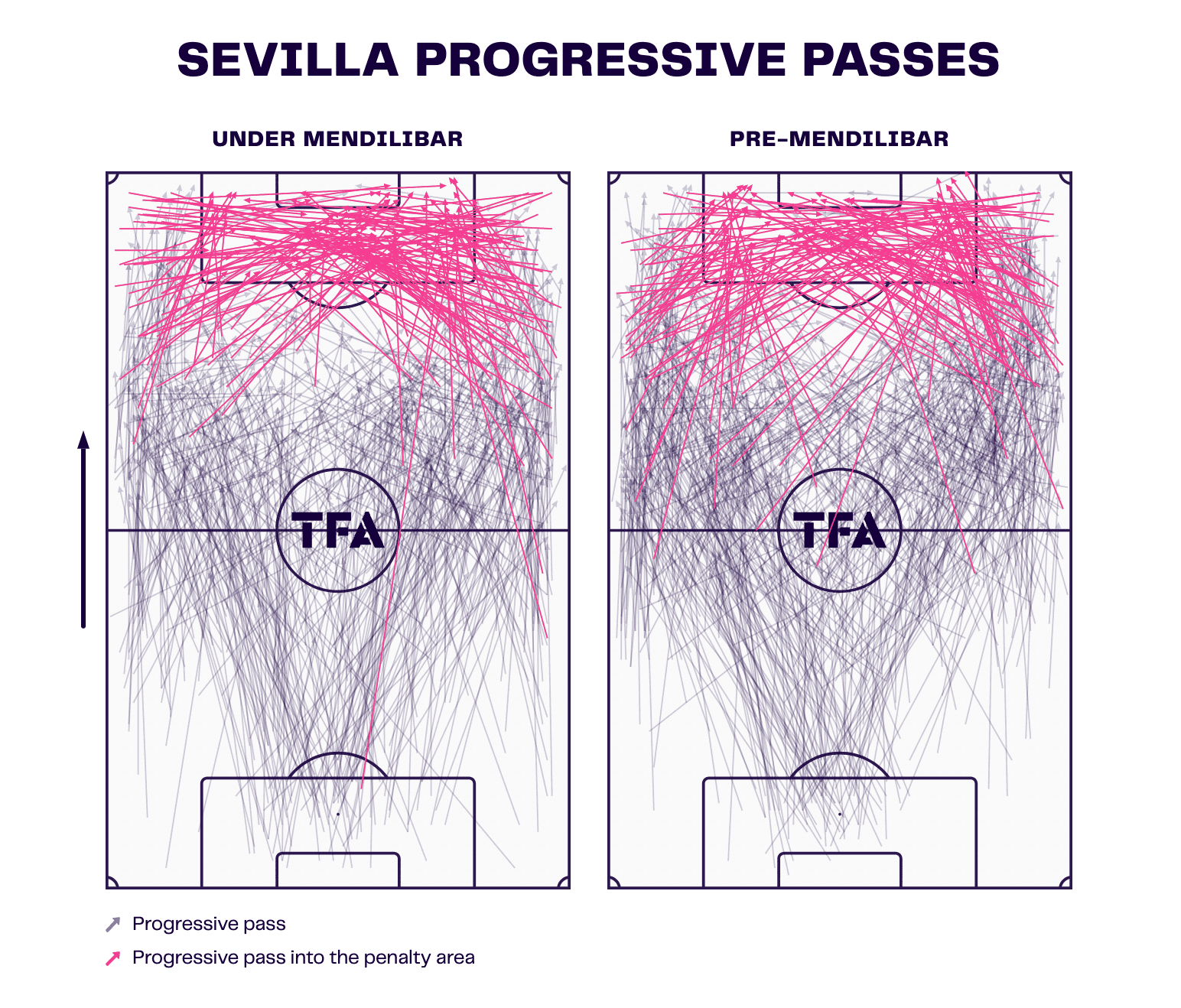
Similarly, while moving Rakitić back to the centre, improving his presence there, has helped in some regard, there hasn’t been enough progress on improving Sevilla’s central presence overall.
The overreliance on crossing and wing play that was evident during Sampaoli’s tenure during the progression phase and chance creation phase has persisted throughout Mendilibar’s time at the club. In fact, Sevilla have played even more crosses (22.0 per 90) in the last 10 games than they did before their new coach’s arrival (18.5 per 90), while they’ve played fewer ‘smart passes’ (defined by Wyscout as: ‘A creative and penetrative pass that attempts to break the opposition’s defensive lines to gain a significant advantage in attack’) in the last 10 games (2.65 per 90) than they did before (3.76 per 90).
So, varying up their chance creation, becoming less predictable and creating more through the centre to give themselves a presence in the high-value areas found in the middle of the park should be a goal for Mendilibar and his team to add a new dimension to their game heading into 2023/24.
Summer transfer targets
Our final section of this scout report provides some potential transfer targets for Sevilla heading into the 2023 summer transfer window. Sevilla signed experience last summer and that left them with the second-oldest squad in LaLiga last season (29.2). It would benefit Los Nervionenses to lower their average age and bring some youth and energy into the side, so all of our recommendations will be aged 24 or younger, targeting players yet to enter their prime.
Firstly, we mentioned above that Sevilla must improve in front of goal, with their xG per shot falling quite low.
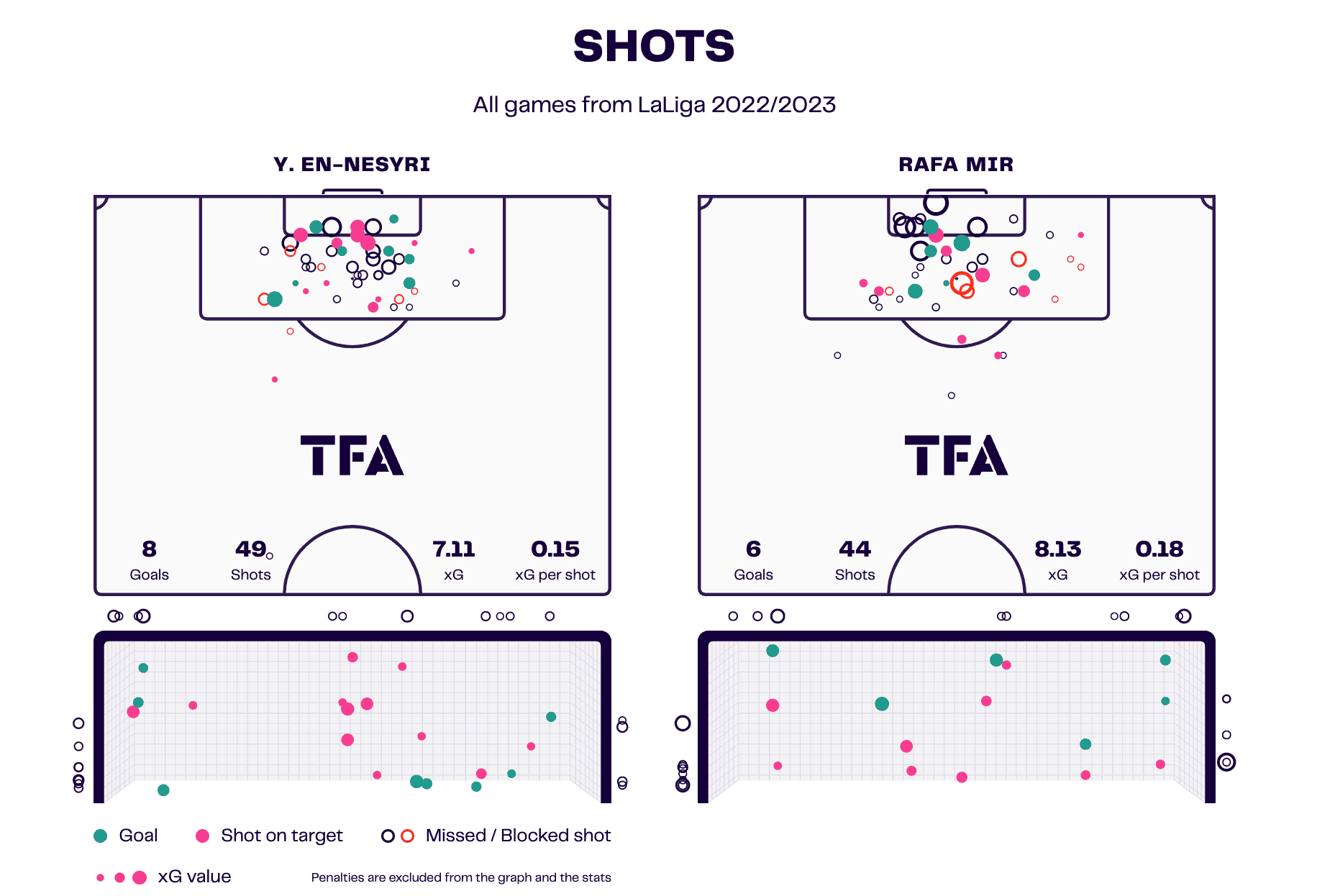
In fairness, their two main centre-forwards from last season (Youssef En-Nesyri and Rafa Mir) have decent xG per shot ratings but they’ve failed to generate enough goalscoring opportunities. Perhaps with an improvement in service designed better for these players and their strengths, they won’t be bad options but even then, it’d be risky for Sevilla to go into the start of another season with just these two options up front after last season.
Another option at centre-forward mightn’t be bad, either as a replacement for one of these two or even as an additional option.
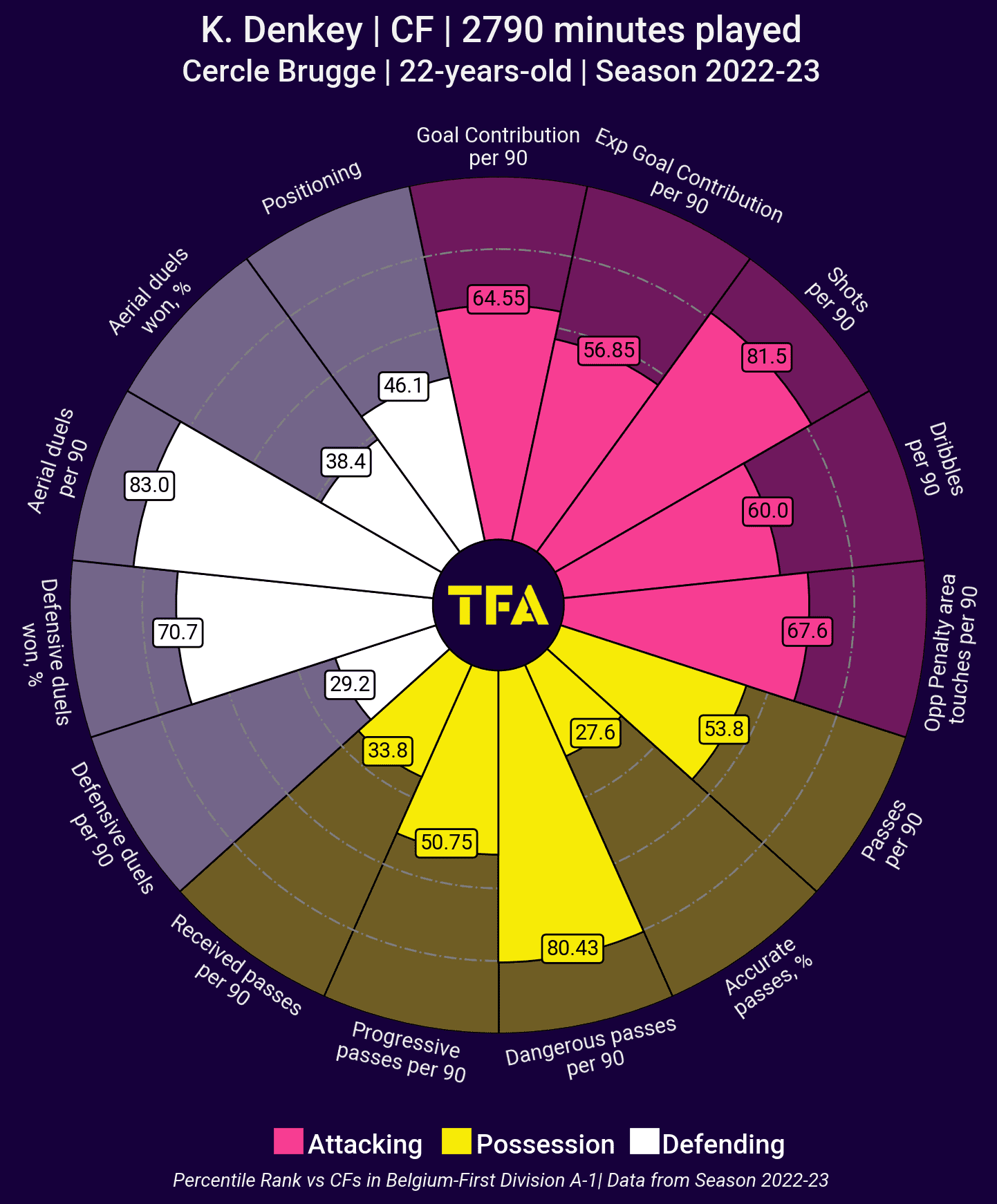
The Belgian Pro League is beaming with talented centre-forwards at the minute, such as Victor Boniface and Gift Orban. Both of them would be interesting options for Sevilla but may be more in demand. Another option that could fall slightly more under the radar is Kévin Denkey.
Denkey is a high-volume shooter who typically attempts shots from valuable areas — and finishes them quite well. If Sevilla could provide him with the necessary service, a step up in level could be attractive and appropriate at this time. Whether or not he’s the right fit for the team and/or league is questionable but there are certainly some evident attractive qualities about Denkey that Mendilibar could work with.
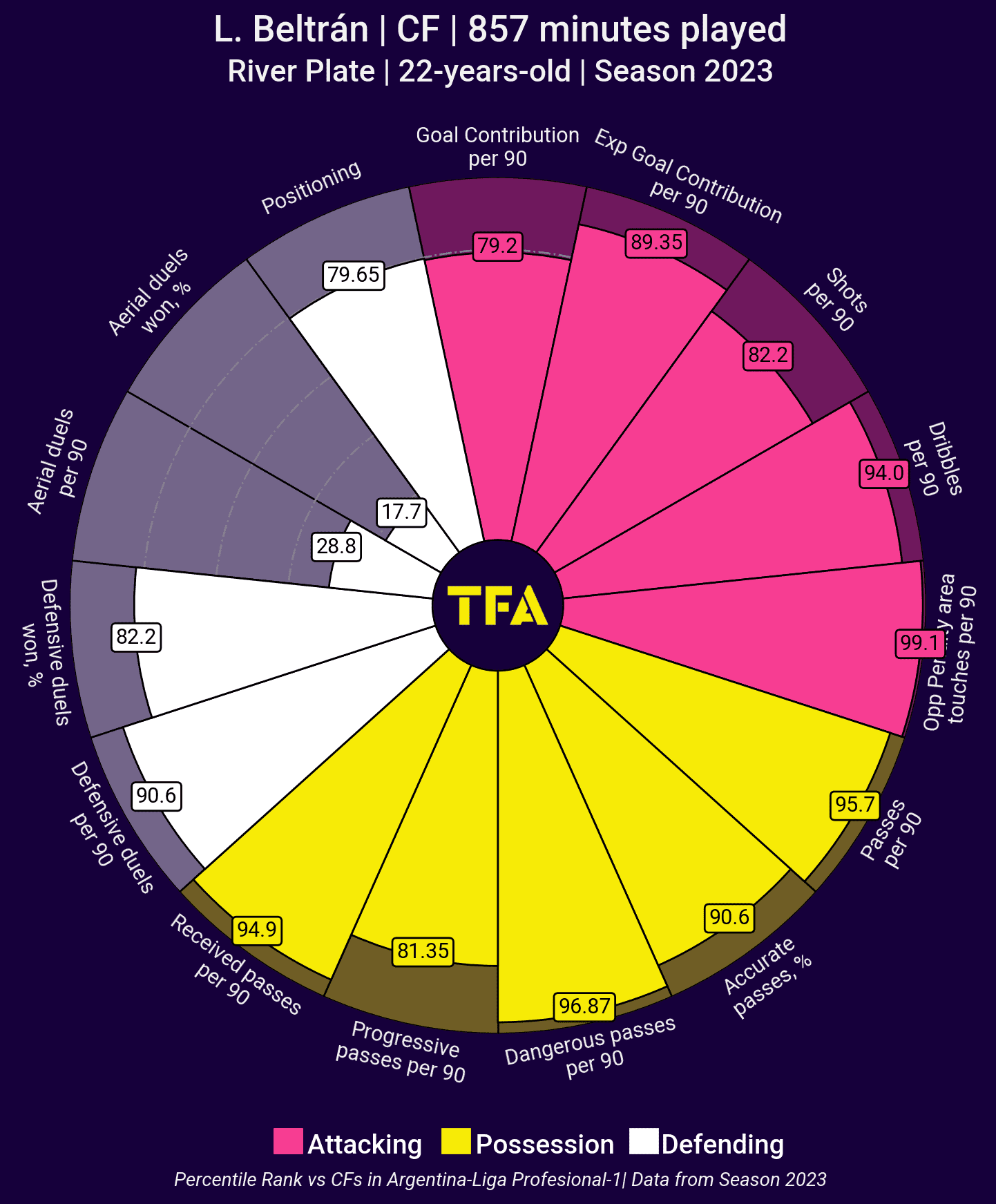
Argentina is a market that Sevilla have dabbled in of late and River Plate’s Lucas Beltrán is one of the most in-form strikers in Argentina’s top flight at present, as the above pizza chart suggests.
Beltrán loves to get involved in his team’s chance creation play, so if Sevilla are looking for someone who can provide that link between midfield and attack by dropping for balls into feet and providing good hold-up play, Beltrán may be a good option. Additionally, he is another high-volume shooter who typically attempts shots from decent positions.
Both of the forwards we’ve selected also provide a lot without the ball in terms of their defensive contribution. Again, we know Mendilibar requires a lot of defensive work rate from his entire team, so there’s no sense in signing a striker who can score goals but not do the necessary work off the ball — it wouldn’t be the right fit. Perhaps one of these two could, though!
Next up, we also discussed Sevilla needing to improve their chance creation in central areas — and there is something of a lack at the attacking midfield position with Mendilibar switching to the 4-2-3-1 from Sampaoli who didn’t necessarily require this type of player in his system. As a result, a central creator could do a lot of good for Mendilibar’s squad heading into next season.
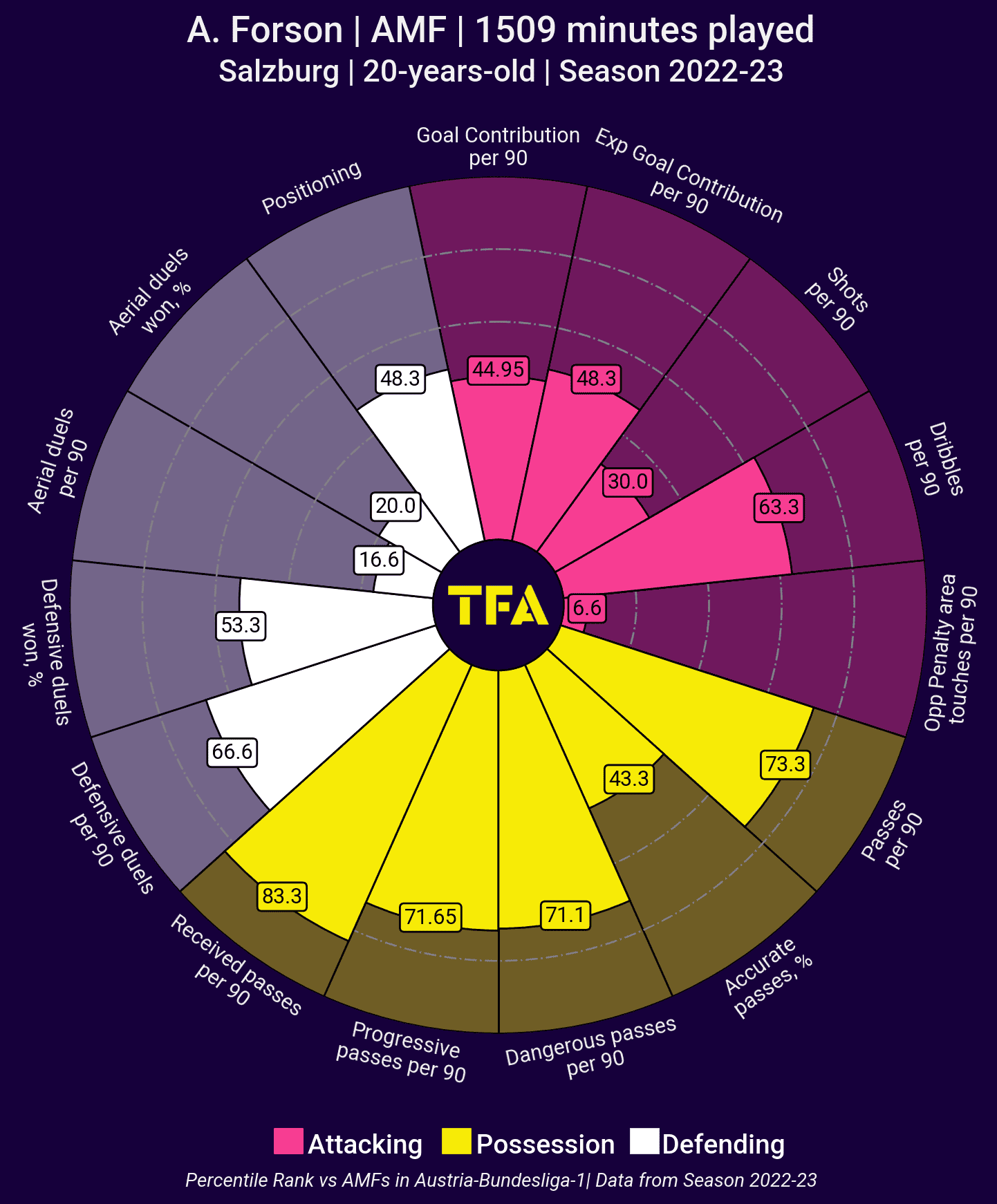
One of the more exciting options on our list in general is 20-year-old Amankwah Forson of Red Bull Salzburg. A plethora of young talents have shot to European superstardom via this pipeline in recent years and this young attacking midfielder could well be the next one to do so. If there’s any chance of prising him away from Salzburg’s grip now, Sevilla could be able to provide him with a platform to hone his game.
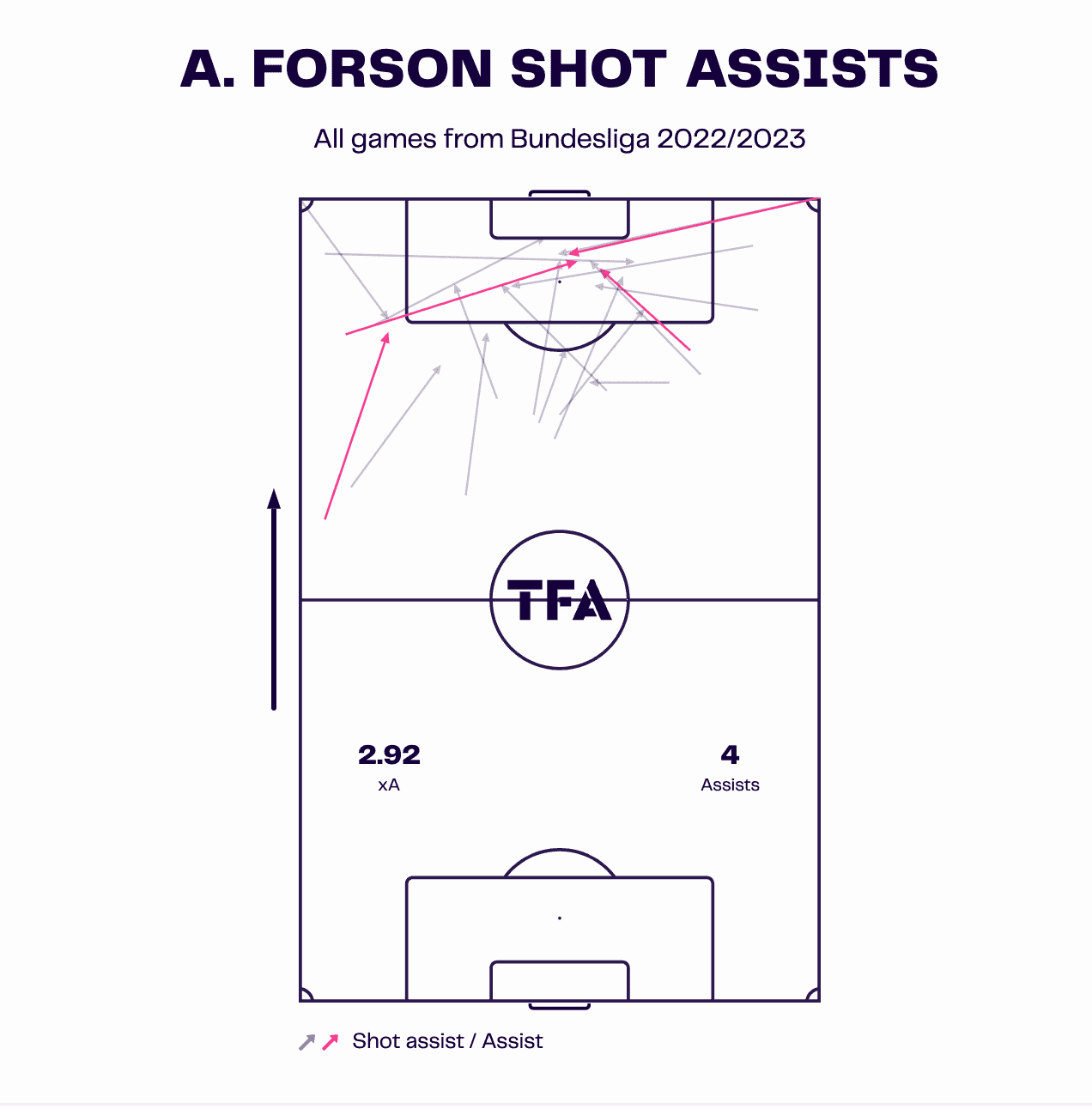
Again, Forson is active without the ball as you might imagine from a graduate of the Red Bull school. He’s also good at providing service from central areas just inside or just on the edge of the final third, as the above shot assist map suggests. He’s a fairly high-volume dribbler who’s comfortable trying to take the game into his own hands (or feet) as well — he could be a player that we see teams can rely on in crucial moments as his career progresses.
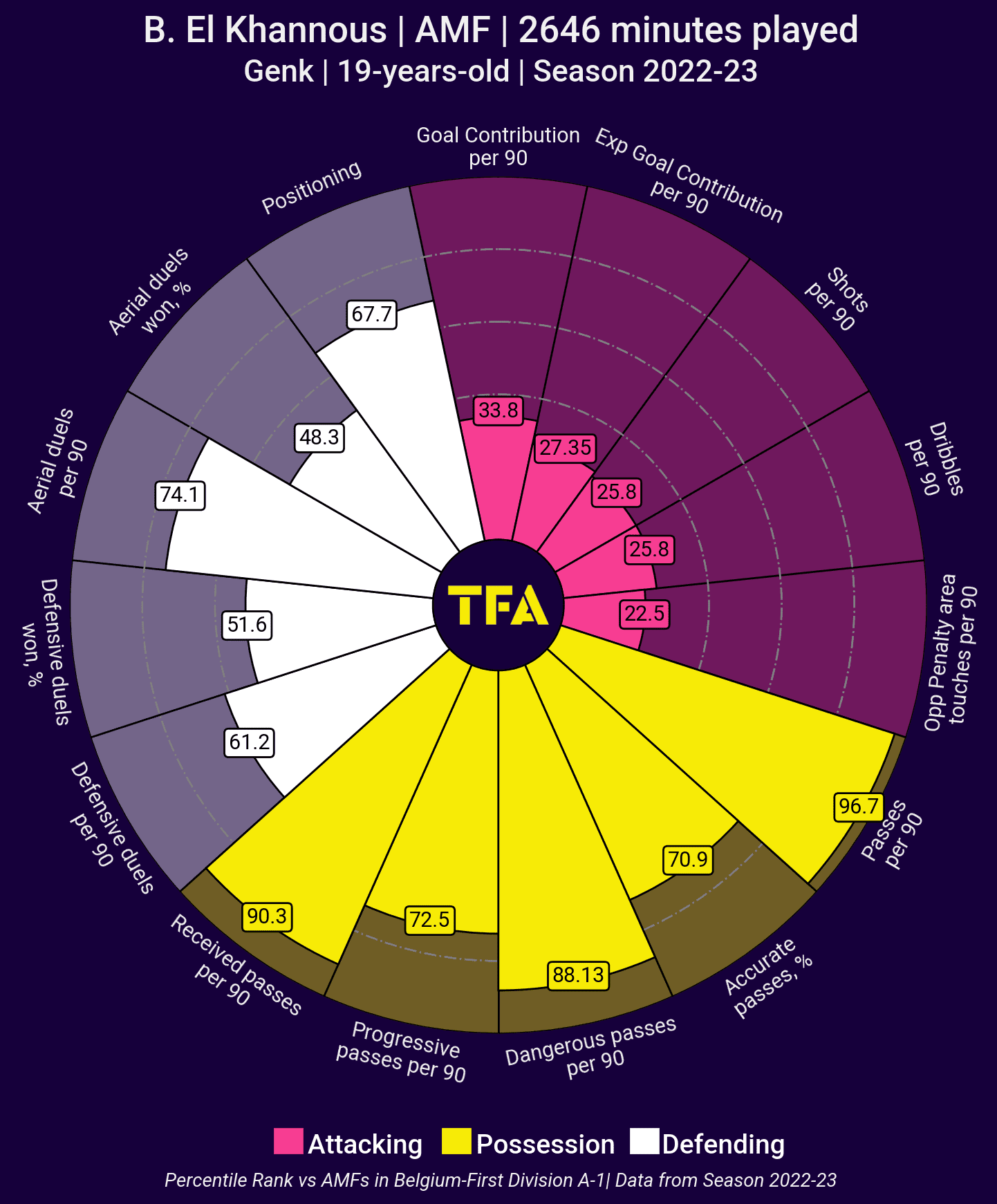
Returning to Belgium, Bilal El Khannous is another option Sevilla could consider for the attacking midfield position if this is indeed an area that they want to bolster heading into 2023/24.
El Khannous is an excellent provider as the pizza chart above indicates. He loves being involved on the ball with great regularity and constantly roams about trying to find little pockets of space in or on the edge of the final third for his team to find him as the player to quickly flick the switch and turn a period of possession into a viable goalscoring opportunity.
Yet again, El Khannous provides work rate off the ball too, ensuring that Sevilla don’t sign someone who doesn’t fit Mendilibar’s out-of-possession philosophy.
Lastly, centre-back is another area Sevilla may need to look at, however, they have some pretty good options that they may be able to secure. For instance, it appears likely that Loïc Badé will return to Andalusia next season, which would undoubtedly be a boost for the team as he remains a promising young centre-back with solid potential.
Meanwhile, Federico Gattoni will return to Sevilla from his successful loan spell with San Lorenzo for next season and could compete for a place in the squad. So, Los Nervionenses do have options here and may not need to look beyond those for now.
Conclusion
In conclusion, it’s clear that Mendilibar’s more direct and slightly more traditional approach in possession suits this squad better than the styles of his direct predecessors in 2022/23, hence why we saw a major upturn in form following the 62-year-old’s arrival. Equally, Mendilibar’s out-of-possession approach has also been a game-changer for this team and looks like being a key factor in any success they have with Mendilibar next term.
Still, they can improve further and push on to make themselves a viable competitor in the UEFA Champions League, progressing beyond the group stages, if they recruit intelligently and to the manager’s philosophy and vision this summer.





Comments